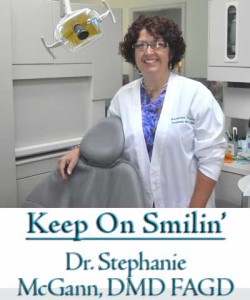A cracked or broken tooth is not something to ignore
By Dr. Stephanie McGann, DMD, FAGD, Columnist, UnionvilleTimes.com
 Rarely a day goes by that I don’t hear about a broken tooth. Broken or cracked teeth are the most common reason that tooth needs crown or even root canal treatment. A broken tooth is one of the most common dental emergencies. Why does this happen?
Rarely a day goes by that I don’t hear about a broken tooth. Broken or cracked teeth are the most common reason that tooth needs crown or even root canal treatment. A broken tooth is one of the most common dental emergencies. Why does this happen?
There are several reasons that teeth break.
Old silver amalgam fillings contribute to broken and cracked teeth. Once upon a time amalgam fillings (a mixture of silver alloy and mercury) were the only reliable dental filling material. Today we know that amalgam restorations are rarely the treatment of choice. Even the best dentist in world cannot overcome the laws of nature. Silver fillings expand with heat more than the tooth. This expansion causes cracks and weakens the tooth. Some older amalgams swell with time and actually start to squeeze out of the tooth. This outward pressure causes teeth to crack. Newer composite materials have expansion properties that more match the tooth.
Some teeth just seem to break. This kind of fracture is usually attributed to micro cracks in the tooth that may have been present for years. Bite just right and you hear the crack or start chewing a piece of tooth. These teeth usually break when you are eating the softest thing imaginable. It’s hard to explain how that pudding caused a tooth to break, in reality, it wasn’t the pudding, the tooth was going to break and chose the pudding to do it in!
Grinding and clenching – this phenomena is called bruxism. The cyclic clenching and grinding is often responsible for worn teeth, missing enamel and cracks. Many bruxers break teeth that have never had a filling. Dental fractures caused by chronic grinding could be referred to as “stress fractures.” Ok, not really but you get the point.
Tooth decay can be responsible for a broken tooth. If a tooth has decay, particularly the kind we find with x-rays in between the teeth, the tooth can be weakened and when a person bites down, the enamel cracks away like and eggshell. This kind of fracture could be prevented with a simple filling before the decay becomes so extensive that tooth is a hollow shell.
Abused teeth are more prone to breakage. If you chew ice on a regular basis, you may be setting yourself up for a cracked tooth (or teeth) in the future.
So what do I do now?
Once a tooth is broken, the first step is to identify that area of tooth that is compromised. The extent and location of the fracture has an impact on the outcome. A simple break is above the gum line, and is superficial in nature. These breaks usually can be repaired with a crown.
A break that goes deeper into the tooth may require root canal (endodontic) treatment as well as a crown to function normally again.
Every once in a while, a tooth will fracture through and through. This kind of break often separates the roots of the tooth or breaks well below the gum line. Most of these teeth will end up being removed. These locations are ideal for implant placement in the future.
How can I keep my teeth from breaking?
When your dentist mentions that you have large old silver fillings, consider replacing them. If he or she is concerned about them, don’t wait. Have the old silver removed, and a new restoration or crown placed before the break happens. This is prudent maintenance. If you have a tooth that is broken but doesn’t hurt, don’t wait. When it starts to hurt, we probably have more work to do than when it first broke. If you grind your teeth, have a guard made. If you think you have decay, get it filled before the tooth crumbles. Dentistry is a perfect example of the old “stitch in time” adage. If you keep up with dental care and preventive maintenance, your teeth will be less likely to fracture. Ignore them, and one day you will be crunching on something wondering, Is that my tooth?
Cracked Tooth Syndrome:
A tooth that hurts inconsistently when biting or chewing may be suffering from cracked tooth syndrome. The pain can be mild to intense. It may go away for days and then come back. Certain foods may make it hurt worse than others. The trouble with cracked tooth syndrome is that it may be hard to determine which tooth is the culprit. Once the cracked tooth is identified, a crown may be placed to support the tooth and prevent the pain.
If you or someone you know has a broken or cracked tooth, inconsistent pain or is clenching or grinding their teeth, please contact your dentist. Today.
Dr. Stephanie McGann is a resident of the Unionville area and along with her partner, Dr. Marie Scott, operates The Brandywine Smile Center, a family-friendly dental practice in Concordville. She is a Fellow of the Academy of General Dentistry.







I recently had my routine dental appointment; evaluation by the dentist and a full set of x-rays. Everything looked great said the dentist. I scheduled my cleaning with the hygienist. The hygienist did the cleaning and polished my old amalgam fillings. After which she discovered a cracked tooth. My question is, if it was cracked why didn’t it show up on the x-ray or could the polishing have caused the crack?